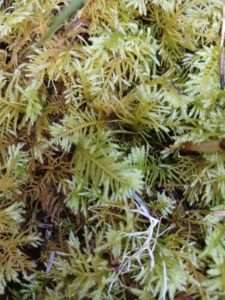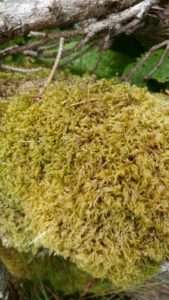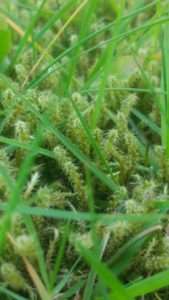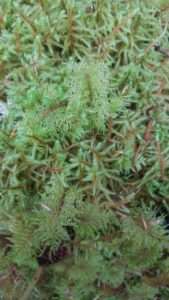Last week I wrote about why it’s important to preserve all sorts of ecosystems, not just forests. Today I want to discuss an ecosystem-within-an-ecosystem you may not have realized was there, and why it’s so important to preserve it: moss forests.
What Are Moss Forests?
 Recently I was listening to this episode of NPR’s Radiolab, featuring the work of Korena Mafune and Nalini Nadkarni. The show focused on the diverse and highly important ecosystems centered around moss, high up in the trees, and how even the trees themselves benefit from their mossy coverings. Many people think of moss only as something that grows on trees, rocks, and roofs, and as a nuisance which often needs to be removed from lawns and sidewalks. Yet these humble bryophytes are the foundation of their own miniature ecosystems, as important to them as trees are to larger forests.
Recently I was listening to this episode of NPR’s Radiolab, featuring the work of Korena Mafune and Nalini Nadkarni. The show focused on the diverse and highly important ecosystems centered around moss, high up in the trees, and how even the trees themselves benefit from their mossy coverings. Many people think of moss only as something that grows on trees, rocks, and roofs, and as a nuisance which often needs to be removed from lawns and sidewalks. Yet these humble bryophytes are the foundation of their own miniature ecosystems, as important to them as trees are to larger forests.
Within the tangled green of moss forests lives a wide variety of beings. Springtails are tiny arthropods; while they have six legs, they are only related to insects and not a part of that class. Some species are carnivorous, hunting even tinier creatures like nematodes and tardigrades; others are herbivores, grazing on the moss and other small plants, while still others are omnivores. There are even detritivorous springtails, which feed on decaying matter and help release nutrients into the food web.
The springtails aren’t alone, though. They are a favorite prey of spiders that hunt in moss forests. And both aquatic and terrestrial invertebrates make their homes here. The aforementioned nematodes and tardigrades, as well as rotifers, are just some of the aquatic beings that thrive best in the rainy months when the moss holds pools and droplets of water. Drier times are better for the springtails, as well as their neighbors, the mites, along with various other insects, spiders, and other invertebrates. Like a seasonal wetland, the mosses help to preserve water even after the rains have ended, and allow the beings who live within their leaves to survive and thrive year-round.
So why care about such little living beings? Well, for one thing, they’re important parts of the food web, in which small beings are eaten by bigger ones, which themselves are then eaten by even larger ones. So a spider hunting springtails in the moss could be eaten by a small salamander, which is then caught and eaten by a garter snake, who then ends up as lunch for a great blue heron chick being fed in the nest by its diligent parents.
But they’re also important in their own existence, as are all beings. Too often we only ascribe importance to living beings that we consider to be economically valuable, or that are charismatic megafauna or flora. It’s easier for us to want to help endangered tigers or rhinoceroses, but the smaller, less flashy beings have fewer cheerleaders. And that’s a problem.
Stealing the Forest Away
 Many people, me included, have read and enjoyed Braiding Sweetgrass by Robin Wall Kimmerer. While I thoroughly enjoyed it myself, I actually like her earlier book even more! Gathering Moss: A Natural and Cultural History of Mosses is exactly what the title says: an immersion into not only what mosses are and how they support local ecology, but their importance to a wide variety of indigenous communities and traditions.
Many people, me included, have read and enjoyed Braiding Sweetgrass by Robin Wall Kimmerer. While I thoroughly enjoyed it myself, I actually like her earlier book even more! Gathering Moss: A Natural and Cultural History of Mosses is exactly what the title says: an immersion into not only what mosses are and how they support local ecology, but their importance to a wide variety of indigenous communities and traditions.
One of the things that really made my heart sink was when Kimmerer wrote about commercial moss collection. The entire chapter “The Bystander” describes in painful detail how commercial moss collectors will rip away moss forests from their tree branches, stuff them in sacks, and carry them away. Moss does not generally grow back after these “clearcuts”; it started growing on the trees shortly after they sprouted and began seeking the sun, which means the moss hunters were wholesale destroying colonies that could have been centuries old.
And they didn’t just take the moss, either. As Kimmerer describes: “…in the bag are also untold billions of beings who made that moss their home, like birds nesting in a forest. Scarlet Orbatid mites, bouncing springtails, whirling rotifers, reclusive waterbears, and their children: shall I say all their names in a requiem mass?” (p. 153)
The bags of kidnapped moss forests are then carried to buyers who trade these priceless ecosystems for a few dollars. The moss is then dried–killing anything left alive–and sold to florists who want a more “natural, wild” appearance in their arrangements, or gardeners who use it as a mulch in pots and beds. Large sheets of moss may be dried intact, dyed, and used as indoor decoration, far from the forests they came from. Dried moss is used to stuff wire-frame animals, trying to evoke the wilderness while destroying the wilderness.
Yes, there are commercial moss hunters who do things legally (though Kimmerer writes that “Illegal harvest is thought to be as much as thirty times higher than the legal quota.” p. 154) Some even try to use more sustainable practices, such as taking no more than 50% of moss in a given area, or only collecting moss from rocks. But when the moss that remains grows very slowly no matter its substrate, and literally cannot grow back on the now-bare tree branches–older branches are too smooth to allow the moss to recolonize them–what good is 50% as a target? Especially when illegal poachers may come along and steal the rest? And especially when even the legal moss hunters are still killing billions of tiny invertebrates, the backbone of a forest food web, with every haul?
Preserving Moss Forests into the Future
 None of the commercial uses for moss are a matter of life and death for humans, but they certainly are for the moss forests. No one needs to have draped sheets of dried moss in their home or business, and no one needs to pretend their wood-paneled living room is a forest by placing a moss-stuffed wire deer in the corner next to some birch logs. Florists with their high environmental footprint do not need to add to their impact by fueling the demand for mosses to adorn temporary arrangements that will ultimately end up in the trash once they wilt and turn moldy. Even peat, which often contains large amounts of moss in varying states of decay, is no longer a necessary source of fuel, especially when greener energy sources are on the rise.
None of the commercial uses for moss are a matter of life and death for humans, but they certainly are for the moss forests. No one needs to have draped sheets of dried moss in their home or business, and no one needs to pretend their wood-paneled living room is a forest by placing a moss-stuffed wire deer in the corner next to some birch logs. Florists with their high environmental footprint do not need to add to their impact by fueling the demand for mosses to adorn temporary arrangements that will ultimately end up in the trash once they wilt and turn moldy. Even peat, which often contains large amounts of moss in varying states of decay, is no longer a necessary source of fuel, especially when greener energy sources are on the rise.
So what do we do from here? The easiest way to help slow the demand for moss is to simply not buy it. Avoid home decor that has moss incorporated into it, or only buy these items secondhand (which may involve haunting thrift shops, which generally offer better prices anyway!) If you absolutely must buy floral arrangements, see if you have a florist who grows their own flowers and other plants rather than importing hothouse flowers that must be flown in from thousands of miles away, and skip the moss entirely.
If you decide you want to grow a moss lawn (which is more ecologically friendly and easier to maintain than grass), either transplant small “starters” of moss from rocks and soil (not trees!) in nearby ecosystems that have large amounts (assuming it’s legal to do so), or buy from a moss supplier. In the case of the latter, I encourage you to ask where the moss comes from, how it’s harvested, what sustainability guidelines the company uses, etc. The more you know about where your moss is sourced, the better decisions you can make.
But we also need to pressure our legislators to protect moss. Most of the U.S. moss forests being stripped away are either from the Pacific Northwest or the Appalachians, and for the most part all you need is a permit to collect legally on some areas of land–or to be very sneaky if you decide to go collect where it’s prohibited and enforcement is difficult to nonexistent. Those of us in these states need to be contacting our elected officials, as well as the various natural resources entities, to urge them to end the commercial collection of mosses entirely.
 And we need to educate others. Most people have no idea this is a problem! When people are empowered with knowledge, they are more likely to make conscious, informed decisions. Yes, it doesn’t work 100% of the time, but some of the time is better than none of the time. Every person who realizes what’s going on and wants to do something about it is one more voice adding to the message.
And we need to educate others. Most people have no idea this is a problem! When people are empowered with knowledge, they are more likely to make conscious, informed decisions. Yes, it doesn’t work 100% of the time, but some of the time is better than none of the time. Every person who realizes what’s going on and wants to do something about it is one more voice adding to the message.
You can even start by sharing this article with others–the links throughout the text are good resources for further reading, as is Gathering Moss. And, as always, you can contact me if you need even more resources.
